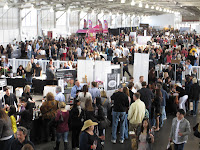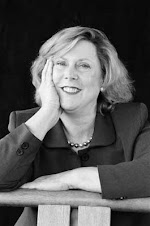 |
| Steve Somermeyer, Judge Finger Lakes Intl Wine Competition |
If you want to see the detailed results for yourself the website for the FLIWC 2012 results is: http://www.fliwc.com/results/2012results.asp
Every year at FLIWC I make new friends and my new panel members quickly became friends. Aaron Mandel, an attorney from St. Louis, Fred Stabins, a certified AWS judge (like Aaron) from Rochester, and Shari Mogk-Edwards, Vice-President, Merchandising and Vintages, LCBO (Liquor Control Board for Ontario). We enjoyed the competition and learned new insights from each other. We had 15-20 minutes to work through a flight of 8 wines and enjoyed 12-13 flights per day. That's plenty of sniffing and spitting for each day. For the judges that can stay, the organizers take us on a bus ride to the Fingers Lakes on Monday. One of the things that makes it special is that they don't pick the wineries to visit until after the competition so that wineries that do well are selected. Usually the bus - 2 this year because of the large number of judges - stops at Camp Good Days so we get a sense of what the camp is. It's a great day to unwind from judging with time to chat with fellow judges and some award winning winemakers.
The FLIWC doesn't award a single Best-of-Show trophy but it does award nice trophies for Best Ice Wine, Best Riesling, Best Chardonnay, and Best Cabernet Sauvignon. The winners:
Best Ice Wine - 2008 A Capella Ice Wine from Black Star Farm near Traverse City, MI
Best Riesling - Also from Michigan and the Leeanau Peninsula, Chateau Fontaine with their 2011 Dry White Riesling
Best Chardonnay - Merryvale Vineyards from Napa Valley, 2010 Chardonnay
Best Cabernet Sauvignon - Washington's Chateau St. Michelle with their 2009 Canoe Ridge Estate Cabernet Sauvignon
I've always felt that wines judged in the first flight of a competition suffer from being the first wines to be judged - judges are getting breakfast tastes out of their palates, working to get calibrated to fellow panel judges, and getting into the pace or rhythm of the competition. With our panel for instance, Shari is used to evaluating many wines in a very short time frame to make purchasing decisions for the LCBO and Fred is a very deliberate judge searching for every nuance while Aaron and I fell somewhere in between. Because of our Midwestern judging experiences, Aaron and I also had more experience with fruit wines so we had a number of amicable discussions as we worked through the wide assortment of wines. It took us several flights to adjust our pace to each other. As mentioned previously I always worry about the results of the first flight of wines so I was very surprised, pleasantly so, when our panel discussed our impressions of the flight of Pinot Gris/Grigio wines and we not only awarded a gold medal to a Michigan Pinot Gris but also a double gold to a Pinto Gris from the Slovak Republic. So much for my pre-conceived notion!
Another pleasant surprise for our panel was a double gold Frontenac blend from Quebec, 2010 Mystere Rouge from Vignoble d'Oka. We had a nice flight of Cabernet Franc's with 4 silvers and 2 gold medals - 2010 from Six Mile Creek Vineyard in Ithaca, NY, and non-vintage blend Americus from LaBelle Winery in New Hampshire. An unfamiliar grape to all of us, Roesler, yielded another double gold medal with 2009 Roesler Reserve from Schachl Harlad in Austria - truly this was an international competition. Our flights of Riesling didn't let us down with a double gold going to the 2010 Riesling from Sandbanks Estates Winery in Ontario and a gold medal to Gallo's 2010 Polka Dot Riesling - a 'value' wine.
Some of the new vintage white wines suffered because of the timing of this competition as many had just recently been bottled and the sulfur aroma that is quite common in newly bottled wines was evident and a distraction. As I reviewed my judging score sheets, there was generally a SO2 comment on each flight of whites.
We also had a nice flight of Syrah/Shiraz with a double gold going to 2009 Stymie Syrah from Steele Wines in Lake County, CA, and a gold going to 2009 Syrah Reserve from Tulip Winery in Israel.
The flight of Cabernet Sauvignon produced a double gold - Kenneth Volk Vineyards 2008 (Volk founded Wild Horse Vineyards in Paso Robles, sold it to Beam, and now has started this winery) and 2 gold medals - J. Lohr Hilltop 2008 and Domaine Napa Wine's 2010 Forest Glen Cabernet Sauvignon, another 'value'. Our Red Bordeaux Blend flight yielded a double gold from Sandbanks Estate Winery in Ontario with their 2009 Shoreline Red plus golds from Paltine Hills Estate Winery in Ontario and Santa Julia Magna from Bodega Santa Julia in Mendoza, Argentina. We also found a double gold in the Merlot class from Cardella Winery in California near Fresno with their 2008 and a gold with 2008 Dvoracke Merlot Barriqu by Vinarstvi Dvoracek in the Czech Republic.
Switching to fruit wines we found 2 double golds in our flight of Blackberry wines - Tomasello Winery in New Jersey and Lagoda Ridge Winery in Missouri. btw, Lagoda Ridge also won gold medals for 2 other fruit wines: a Peach and a flavored Cherry wine, Chococherry Kiss.
Our flight of Ice Wines yielded a double gold from Quebec, Vignoble Riviere du Chene's 2009 Mondo Ice Wine. It also contained a pair of gold medal wines from the same winery - rose-colored Pinot Noir and Cabernet Franc from Royal DeMaria Wines in Ontario. Our last flight of the competition was a flight of artificially frozen 'ice wines' /late harvest wines and we ended up with a bang with two double golds. One was a 2010 Pear from Georgian Hills Vineyard in Ontario and the other was a 2003 Traminette Steyer Vaneja by Steyer Vina in Slovenia.
All in all, we had some excellent wines along with a few stinkers. We awarded 14 double golds which was quite a bit above the average but felt lucky as numerous friends from other tables complained about the 'average' wines they judged. At least one panel didn't find a single double gold among the 200+ wines they judged. I've judged with several from that panel and certainly didn't feel that they were hyper critical when I judged with them.
One can find excellent wine everywhere these days. If you look at the list of the double gold medal winners on the website, you will find winners from 18 states, 3 Candian providences, and 3 other countries. Extending the search to include gold medals would increase these numbers.
Let's look at the results and highlight the wineries that did very well:
A favorite of mine from previous Indy Internationals, Maryhill Winery at the eastern end of the Columbia River Gorge on the Washington side, took a double gold with their 2008 Barbara and golds with
2009 Proprietor's Reserve Zinfandel and 2010 Pinot Gris.
Previously mentioned Lagoda Ridge in Missouri and their fruit wines (see above)
Bending Branch Winery in Texas took a double gold with their 2009 Cabernet Sauvignon and golds with their 2009 Tannat and 2009 Souzao.
Trump (Yes, that Trump) Winery in Virginia got 2 double golds with their 2009 Red Bordeaux Blend New World Red and their sparkling 2008 Blanc de Blanc
Indiana's own Oliver Winery entered quite a few wines and received 2 double golds - 2010 Creekbend Chambourcin and a new label for them 2010 Vintage Sun Cabernet Sauvignon from Mendoza (?) plus a gold medal for their 2011 Creekbend Vidal Blanc.
As mentioned previously Kenneth Volk Vineyards received a double gold from our panel for their Cabernet Sauvignon and also one for their 2008 Santa Maria Valley Pinot Noir plus a gold medal for their 2009 Touriga.
E & J Gallo entered a number of their national brands and their Barefoot wines did very well. Hard to beat in the 'value' (quality:price ratio), Barefoot won golds for Pinot Grigio, Zinfandel, Pinot Noir, and Moscato plus one for the 2010 Alamos Red Blend from Mendoza, the Poka Dot Riesling (from our panel), and the Naked Grape Pinot Grigio. They also won 28 silver medals.
Sandbanks Estate Winery in Ontario won double golds from our panel with their Shoreline Red plus their 2010 Riesling.
Merryvale Vineyards from Napa not only won the best Chardonnay trophy but also got double golds with their 2008 Cabernet Sauvignon and 2011 Starmont Sauvignon Blanc. Chris O'Gormon, who is their Marketing head and judges at FLIWC every year is a great guy and I enjoy interacting with him.
Gloria Ferrer Caves and Vineyards in California won 3 gold medals for
If you'd like to learn more about the FLIWC and Camp Good Days, visit the website to see how you can get involved/help. It's a great cause and it's attracted great people. I'm priviledged to be one of the wine competition judges. http://www.fliwc.com/aboutus.asp
Cheers!
Steve












































